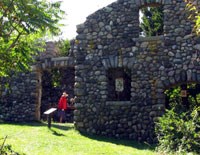

In the 18th century, farming continued on many islands. At least one of the farms on Long at the end of the 17th century (see above) was also present in the 18th (Shurtleff 1890:536). There was also an active farm on Spectacle (Jones 1989:10–12). Nixes Mate was still large enough to permit sheep to be pastured there; livestock were also pastured on Snake in 1775 (Snow1971:97, 147); and farming and pasturage presumably continued at Worlds End (Luedtke 1990:5). Perhaps most indicative of the number and importance of the farms on the Harbor Islands in the 18th century is the fact that most of the military engagements in the Boston area during the Revolution were fought on the Harbor Islands in order to obtain the livestock and agricultural produce raised on them. These engagements took place in 1775 on Grape, Peddocks, Noddles and Breeds, Deer, Long, and Thompson. 
What remains… The historical resources associated with farming and husbandry on the Harbor Islands would be the remains of the farmsteads and pastures that once dotted the islands. Such remains may very well exist on islands where they have not been destroyed by subsequent development. Evidence of farming and/or farmhouses are known to exist on Bumpkin, Grape, Worlds End, and Thompson, for example, and may also be present on the southern part of Long, Rainsford, Lovells, Gallops, and Outer Brewster. Prepared by Nancy S. Seaholes, 2009 |
Last updated: February 26, 2015
